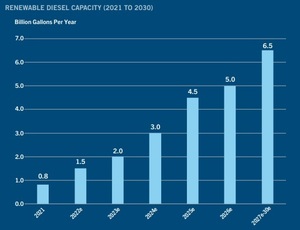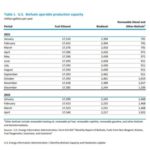CoBank discusses potential boom in renewable diesel capacity
Energy Disrupter
ADVERTISEMENT
CoBank on Sept. 27 published a report that calls renewable diesel the most exciting growth opportunity in the U.S. biofuels space, with proposed capacity increasing from approximately 1 billion gallons in 2021 to 6.5 billion gallons by 2030. That level of capacity would equate to approximately 15 percent of today’s diesel market, according to the report.
Soybean oil is currently the primary renewable diesel feedstock used in the U.S. Theoretically, to support the expected 5.5 billion gallon growth in renewable diesel production capacity, CoBank estimates soybean production would need to grow by 3.4 billion bushels. Even if the U.S. retained all of its soybean exports, projected at 2.5 billion bushels in 2030, biofuel producers would still be short 927 million bushels. Using a future projected yield estimate of 51.9 bushels per acre, meeting the needed production would require 17.9 million more soybean acres, according to CoBank.
Renewable diesel, however, can be produced from a variety of other feedstocks. Besides importing soybeans, alternatives to shifting massive farm acreage would include growing other types of oilseeds, such as canola and sunflower, at larger scale, importing other vegetable oils, and/or using other feedstocks, such as beef tallow, CoBank said in the report.
In the report, CoBank also notes that it expects the recently signed Inflation Reduction Act of 2022 to a be a catalyst for biofuels sector growth over the next decade. Provisions of the law that are particularly beneficial to the biofuels industry include the $500 million allocated to support biofuel infrastructure development; the extension of the $1 per gallon tax credit for biomass-based diesel through 2024; the newly established clean fuel production tax credit and enhanced carbon capture and storage credits/payments; and a temporary tax credit for sustainable aviation fuel (SAF).
A full copy of the report is available on the CoBank website.
















